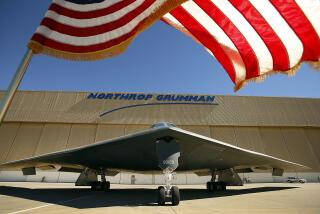Northrop Poised for Dominance, Chairman Says : Aerospace: Kent Kresa says the acquisition of Grumman will give his company an edge in future defense programs.
- Share via
WASHINGTON — Looking more chipper than ever, Northrop Chairman Kent Kresa has spent the past week bounding around the Pentagon, promoting to senior defense officials his latest creation: the Northrop Grumman Corp.
Kresa is broadcasting the message that Northrop’s pending $2.17-billion acquisition of Long Island-based Grumman would create a new aircraft industry powerhouse that will emerge in the next several years as an equal to McDonnell Douglas and Lockheed.
In the Grumman deal, Northrop has put together the key technologies that will dominate future defense programs, Kresa said in an interview between visits to Defense Secretary William Perry and the Pentagon brass. The deal is expected to close Friday.
Although Northrop has suffered through plenty of disappointments in recent decades--losing major competitions and becoming embroiled in national scandals--its saving grace has been a keen ability to predict how radical new technologies would drive defense markets. That knack has yielded the firm a handful of multibillion-dollar programs, including the B-2 stealth bomber.
But the biggest test of that trademark Northrop skill will be played out over the next five years, as Kresa attempts to make good on his theory that future defense programs will combine reconnaissance, long-range strike capability and precision weapons.
Kresa made the rounds in Washington saying the Grumman acquisition would give Northrop a broader capability and more existing programs in these areas than any rival. Moreover, Northrop’s knowledge of the whole technological picture provides an advantage in competing for any of the parts, Kresa said.
Aerospace experts and analysts say that Northrop stands to gain so much technical capability and breadth with the Grumman deal that it is now far more likely to be a survivor of the aerospace bust of the 1990s.
“Their success will depend more on how they are managed now than anything else,” said John Harbison, director of the aerospace consulting practice at Booz Allen & Hamilton. “Northrop has the opportunity to accomplish things through (consolidation) that McDonnell Douglas and Lockheed do not.”
At Northrop’s swank Washington offices overlooking the Potomac River, Kresa acknowledged that he has not been so upbeat about Northrop’s prospects in a long time.
“I love the opportunity to build something exciting,” Kresa said. “I feel very positive that this is a winning situation for everybody involved.”
Kresa, a model of temperance, expressed no regret that he lost prior bids for other defense units over the past two years. He also rejected the idea that personal hostilities or ego played any role in Northrop’s aggressive bidding for Grumman. (Northrop’s offer topped a $1.93-billion bid by Martin Marietta.)
Rather, Kresa insisted that the Grumman deal reflected only Northrop’s long-held strategy to focus on the military aircraft and defense electronic markets.
“We certainly have the opportunity to be an equal,” Kresa said about his rivals. “We are an $8-billion defense company now. Our technology is world class in many areas.”
Unlike its rivals whose corporate cultures have grown to resemble bland bureaucracies, Northrop has taken big risks and attempted to preserve the technological free thinking that was the hallmark of U.S. aerospace decades ago.
The result has been stunning successes--mixed with a few embarrassments and a corporate culture sometimes notable for its eccentricities.
When competitors were trying to build faster jets in the early 1970s, Northrop instead began working on stealth technology that would make its jets invisible to enemy radar. That savvy bet yielded the B-2 bomber program.
In the 1960s, it began work on a revolutionary floating ball gyroscope technology that won the firm the guidance system for the MX missile. And in the early 1980s, Northrop engineers began tinkering with advanced microphones that could listen for enemy tanks, a radical concept that resulted in the Bat strike weapon.
But the firm also spent $1.2 billion of its own money on the F-20 fighter, an effort that failed to win a single order. In some programs, Northrop also failed to deliver weapons on time, within budget and up to the required performance.
And it became infamous during the 1980s for its succession of scandals, leading to a guilty plea on federal felony charges in 1991. No new allegations have hit the firm for several years.
The end of the Cold War has created the notion that the defense market has been permanently reduced. But some experts believe that the current bust is so deep that another boom is likely in several years and the market will support all of the current military producers--Lockheed, McDonnell Douglas, Boeing and Northrop.
By early next century, Air Force and Navy aircraft will be decrepit and in some cases obsolete.
Kresa believes that the Grumman acquisition will give Northrop the strength to bridge the 1990s until the market turns up.
Even the fortunes of the long controversial B-2 appear to be rising. Senior congressional and Air Force leaders have begun to support the acquisition of more than the 20 aircraft now on order. Later this month, Congress will convene hearing on the future of the bomber industry, a significant step in increasing the B-2 order book, Kresa said.
More to Read
Inside the business of entertainment
The Wide Shot brings you news, analysis and insights on everything from streaming wars to production — and what it all means for the future.
You may occasionally receive promotional content from the Los Angeles Times.











